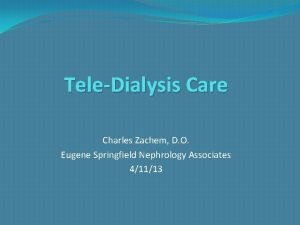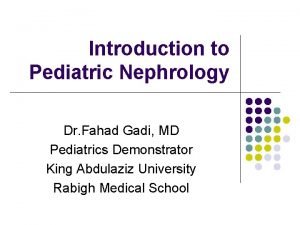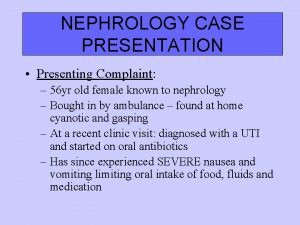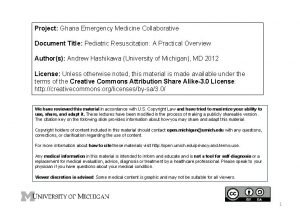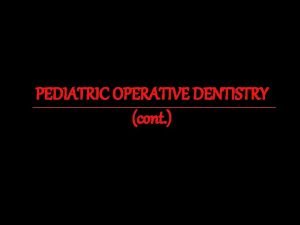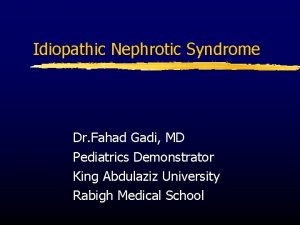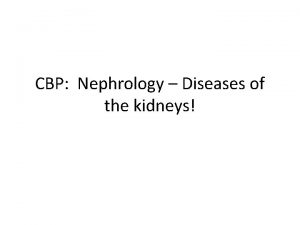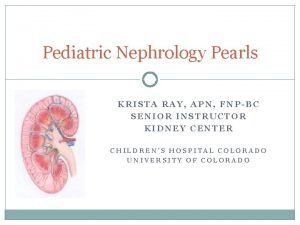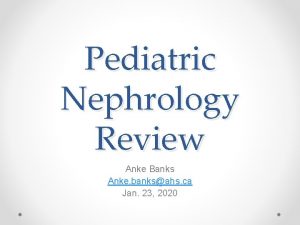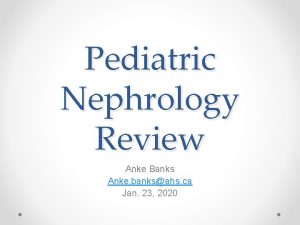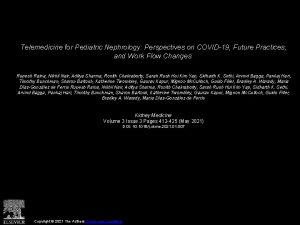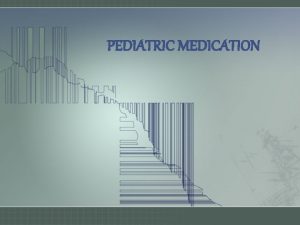Introduction to Pediatric Nephrology Dr Fahad Gadi MD











































- Slides: 43

Introduction to Pediatric Nephrology Dr. Fahad Gadi, MD Pediatrics Demonstrator King Abdulaziz University Rabigh Medical School

Kidney ontogenesis l l The embryological development of the kidney is a long and continuous process which begins in the 3 rd week and is completed by about 34 -35 weeks of fetal life. Kidney organogenesis is characterised by 3 distinct and linked stages: pronephros, mesonephros and metanephros.

Kidney ontogenesis l In humans, the first two are transient structures with little excretory capacity but they are important for the appropriate development of the metanephros, which is the direct precursor of the adult kidney.

METANEPHROS l l l The final stage of the kidney is the differentation of the metanephros and arise from the ureteric bud and the metanephric blastema (mesenchyme). The renal pelvis, major and minor calyces and terminal collecting duct are formed by the 10 -13 th wks of ges. After morphogenesis each kidney contains approx a million nephrons.

Renal development Pronephros aorta nefrotomy Przednercze 3 t. ż. 4 -8 t. ż. Mesonephros przewód Wolffa Śródnercze 5 t. ż. Metanephros stek pączek moczowodowy blastema nerki ostatecznej Nerka ostateczna

Antenatal Period l l l The most common cause is physiologic dilation. Metanephric urine production begins at 8 weeks, even before ureteral canalization is complete. Transient obstruction with hydronephrosis occurs.

Embryology



MOLECULAR ASPECT l l The development of the metanephric kidney depends on inductive interaction between the ureteric bud (UB) and the metanephric mesenchyme (MM). A large number of genes have been found to be crucial during kidney development.

Nephrons l l In the fetus at 36 weeks’ gestation there is an adult complement of nephrons- approx. one million All further growth of the kidney is via hyperplasia mainly in the tubules.

Fetal kidney l l Nephrogenesis is completed between the 28 and 36 th gestational week in the human, the renal tissue and particularly the tubular cells continue to develop postnatally. Several of the major transporters in the tubular epithelial cells undergo postnatal maturation

Fetal kidney l l Outer cortical glomeruli are relatively underperfused compared with inner cortical glomeruli. Following birth, renal perfusion to superficial cortical nephrons rises compared with deeper glomeruli

Fetal kidney l Angiotensin-converting enzyme inhibitors and angiotensin-receptor antagonists impair nephrogenesis and so are contraindicated in pregnancy

Production of urine l l l Production of urine starts at the age of 10 -12 weeks of gestation: 1. very dilute urine 2. small amount of urine Fetal urine is a major constituent of amniotic fluid and urinary flow rate increases from 12 ml/hr at 32 weeks’gestation to 28 ml/hr at 40 weeks’gestation. Similar increases are described during the maturation of premature newborns.

Glomerular Filtration Rate (GFR) l l l Glomerular filtration begins between the 9 th and 12 th week of gestation in humans. The GFR is relatively low at birth especially in the premature infant. The values of GFR nearly double between 3 and 7 days and thereafter GFR continues to increase, by 1 to 2 yrs of age the GFR is the same as in an older child- 80% of mature kidney.

GFR

Kidney of newborn l l The kidney of the newborn infant has a limited capacity to regulate the excretion of fluid and electolytes. The high sodium excretion during the first 2 to 3 weeks often results in a negative sodium balance and predisposes to hyponatremia.

Creatinine Clearance l l Newborn: 40 -65 ml/min/1. 73 m 2 <40 yrs: 97 -137 ml/min/1. 73 m 2

Renal failure in the newborn l l l Renal failure in the newborn: severe asphyxia, the majority suffered from nonoliguric renal failure

CAKUT l l l Congenital Anomalies of Kidney and Urogenital Tract

CAKUT Chronic renal failure (children): Obstructive nephropathy- 47% Reflux nephropathy- 18, 5% Hypo/dysplasia 8, 7% l

RENAL ABNORMALITIES l Renal agenesis: bilateral fetal death- Potter syndrome 1: 4000 pregnancies unilateral other organ- 1: 2900 pregnancies abnormalites


Renal abnormalities Agenesis Aplasia Hypoplasia

RENAL ABNORMALITIES l Hydronephrosis

RENAL ABNORMALITIES l Obstractive uropathy: A. ureteropelvic junction obstruction- dilated renal pelvis with/ without caliectasis and no dilation of the ureter B. ureterovesical junction obstruction (megaureter)pelviectasis and caliectasis with significant ureter dilation

RENAL ABNORMALITIES l l C. posterior urethral valve D. ureterocele- cystic dilatation of the distal ureter that protrudes into the urinary bladder, may extend past the bladder into urethra E. ectopic ureters F. constriction (stenosis)of urethra

Posterior urethral valve Type I – Type III

Duplication of urinary tract Ureter duplex Ureter fissus Ureter

Vesico-ureteral reflux Frequency of VUR • Isolated • UTI in the past • Siblings with VUR • Mothers with VUR in the past 1% (0. 4 -4%) 29 -50% 32 -45% 60%

RENAL ABNORMALITIES l Polycystic kidney: autosomal dominant p. k. disease autosomal recessive p. k. disease

Kidney ontogenesis

PRONEPHROS l l l Pronephros is a transitory nonfunctional kidney, the first tubules appear the middle of the 3 rd week and arise from intermediate mesodermal cells. The pronephric tubules persist for only a short time and undergo degeneration by the 5 th week. At the time the pronephros is degenerating the mesonephric tubules and duct are developing.

Pronephros


Vesico- ureteral reflux Normal kidney, ureter, and bladder

Vesico- ureteral reflux Grade I Vesicoureteral Reflux: urine (shown in blue) refluxes part-way up the ureter

Vesico- ureteral reflux l Grade II Vesicoureteral Reflux: urine refluxes all the way up the ureter

Vesico- ureteral reflux l Grade III Vesicoureteral Reflux: urine refluxes all the way up the ureter with dilatation of the ureter and calyces (part of the kidney where urine collects)

Vesico- ureteral reflux l Grade IV Vesicoureteral Reflux: urine refluxes all the way up the ureter with marked dilatation of the ureter and calyces

Vesico- ureteral reflux l Grade V Vesicoureteral Reflux: massive reflux of urine up the ureter with marked tortuosity and dilatation of the ureter and calyces

International Classification of VUR Io IIIo IVo Vo
 Miami pediatric nephrology seminar
Miami pediatric nephrology seminar Gadi queue limits
Gadi queue limits Neurosis vs psychosis
Neurosis vs psychosis Fahad subhi muhammad
Fahad subhi muhammad Hypercalauria
Hypercalauria Nephrology near atwater
Nephrology near atwater Nephrology nursing certification commission
Nephrology nursing certification commission Caribbean institute of nephrology
Caribbean institute of nephrology Eugene springfield nephrology
Eugene springfield nephrology Nephrology
Nephrology Pinehurst nephrology associates
Pinehurst nephrology associates Nephrology case presentation
Nephrology case presentation Unc benign hematology
Unc benign hematology Define pediatric dentistry
Define pediatric dentistry Headache red flags
Headache red flags Pediatric seizures
Pediatric seizures Peds vital signs
Peds vital signs 4 2 1 fluid rule
4 2 1 fluid rule Jvas vision screening
Jvas vision screening Pediatric urology salary
Pediatric urology salary Pediatric heart rate chart
Pediatric heart rate chart Axial wall depth in class 2 amalgam
Axial wall depth in class 2 amalgam Trends of pediatric nursing
Trends of pediatric nursing Common pediatric medications
Common pediatric medications When administering ear drops to adults the pinna is pulled
When administering ear drops to adults the pinna is pulled 4 2 1 fluid rule
4 2 1 fluid rule Pediatric first aid for caregivers and teachers
Pediatric first aid for caregivers and teachers Pediatric exercise physiology
Pediatric exercise physiology Kusum viswanathan
Kusum viswanathan Pediatric pat
Pediatric pat Pediatric life support algorithm
Pediatric life support algorithm Pediatric life support algorithm
Pediatric life support algorithm Pediatric vital signs
Pediatric vital signs Normal ranges of vital signs
Normal ranges of vital signs Pediatric triangle
Pediatric triangle Pediatric oncology branch
Pediatric oncology branch Concept of child care
Concept of child care Concepts of child care
Concepts of child care Mary bridge neurology clinic
Mary bridge neurology clinic Pediatric coma scale adalah
Pediatric coma scale adalah Dr br vacher
Dr br vacher Pediatric dehydration fluid replacement formula
Pediatric dehydration fluid replacement formula Pediatric epinephrine dose chart
Pediatric epinephrine dose chart Pat triangle
Pat triangle








